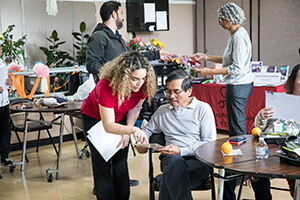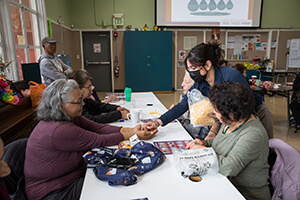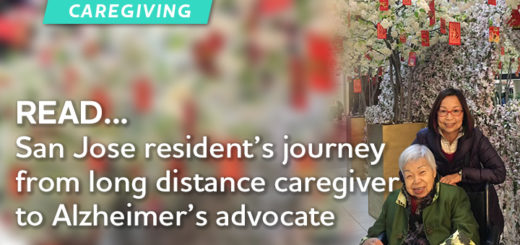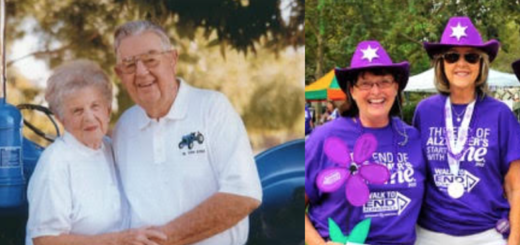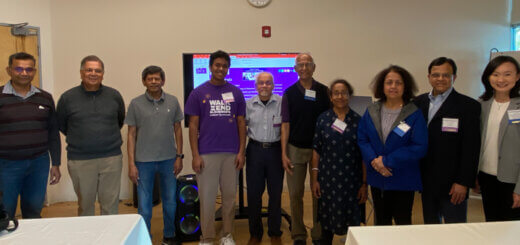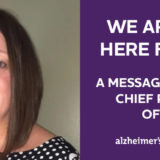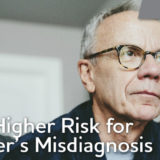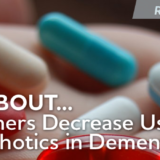Research grant makes clinical trial more inclusive of Hispanics
In late spring of 2022 investigators from the AHEAD Study were awarded grant funds for a new and unprecedented approach to engaging the Hispanic community in dementia research. The University of California, San Francisco (UCSF) was chosen as an intervention site and formed what was called the Consorcio. Working with the National Association of Hispanic Nurses® (NAHN) and the Alzheimer’s Association®, they invited people from Hispanic communities to learn about, and consider participating in the AHEAD clinical trial. We spoke with representatives at UCSF to share more about the AHEAD Study and how Consorcio helped the Hispanic community.
The AHEAD Study
The AHEAD Study, which began in 2022, is trying to determine if there is a way to stop or delay Alzheimer’s disease or another dementia before symptoms begin. The study plans to do this by using the existing drug, lecanemab, to remove existing amyloid (a protein in the brain) before it can build up and cause memory problems.
“We know amyloid is the first to accumulate and can happen 15 years before symptoms,” said Dr. Julio Rojas, Co-investigator and Associate Professor at UCSF. “It may start when they’re 40 or 50 with a slow buildup of this protein. Something happens with age and this accumulation happens fast. Then tau, [another protein in the brain], appears and that’s toxic to brain cells. When brain cells start dying out, then you have symptoms [of memory loss].”
Dr. Rojas goes on to explain that while lecanemab has already been approved for people with symptoms of cognitive impairment or dementia, this is the first time it has been tested in people before symptoms begin. “We know that the drug slows down the worsening of symptoms over time by 20-25%, compared to those patients with mild cognitive impairment (MCI) or Alzheimer’s disease who do not take the drug,” said Dr. Rojas. “What will happen when we give it to someone without symptoms? Maybe the effect will be more robust.”
Reluctance to participate
According to the Alzheimer’s Association’s special 2021 report on Race, Ethnicity and Alzheimer’s in America, approximately 13% of Hispanics who are 65 or older have Alzheimer’s or another dementia. However, 51% say they are reluctant to engage in clinical trials because they don’t want to be “guinea pigs.”
According to UCSF’s Trusting Research website, Alzheimer’s disease is the 8th leading cause of death among the Hispanic community, but many suspect that ranking is likely higher. That’s because cases of Alzheimer’s may not be reported due to being undiagnosed, stigma, or because of a lack of awareness about what Alzheimer’s disease is and how symptoms look. Additionally, Mexican and Central American Hispanics have much higher rates of dementia than the general population.
The special report also shared that 85% of Hispanic individuals are more willing to volunteer for a clinical trial if they are invited to participate and are significantly more likely to volunteer if asked by a person of the same race. With this information in mind, the investigators created a Consortium of national organizations trusted by the Hispanic community; The Alzheimer’s Association and NAHN.
Consorcio
The Consortium, or Consorcio, had a goal of making the Alzheimer’s and dementia clinical trials more inclusive of Hispanic populations. The program was funded for one year by an R24 grant from the National Institute on Aging to Principal Investigator, Elana Portacolone.
Elana identified eight AHEAD sites with large Hispanic populations in the United States that were willing to participate in Consorcio. Four of these sites were chosen at random to use the Consorcio intervention for recruitment while the other four continued with regular recruitment. The four chosen sites were: Boston, Miami, San Antonio and San Francisco.
Working in the community
For the past year, Consorcio has been providing resources and education to the Hispanic community. Several times a month, UCSF, NAHN and the Alzheimer’s Association would come together and set up a booth at a health fair, a music event, in a clinic or anywhere they could find a large Hispanic audience.
“We go into the community and give presentations to senior groups,” said Dr. Rojas. “We let people tell their experience about memory and we discuss what it is. We played some games, like BINGO, and talked about the study. They become aware [of the study] and maybe they decided to participate.”
While the primary goal was to inform people about the trial, their secondary goal was to inform the population about dementia, explaining the signs and sharing the risks. They also create a space for the community to feel comfortable sharing their experiences with the disease and how they can get help if they need it.
“Sometimes, in conversation, we don’t get to the details of the trial,” said Brianna Colado, the Outreach Specialist for UCSF. “Although we may talk about introductory details [of the trial], our conversations go a very long way in sparking interest to learn more through future presentations. We leave our contact information and keep reaching out after the event. That way they are contacted, and they have a trusted individual they can come to with any questions or curiosities in the future.”
Barriers to participation
As mentioned earlier, the stigma of not wanting to be a “guinea pig” plays a large role in deterring Hispanics from participating in clinical trials. “As a Mexican American I can speak from experience,” said Brianna. “We’re very closed off to medical services. People don’t want to come to studies that are done on people. They’re not a guinea pig. It’s not something we easily go to or turn to. Changing that mindset has been a little difficult.”
In addition to stigma there are several other barriers that could be stopping the Hispanic community from signing up for a clinical trial. Here are a few possibilities:
- They are unable to leave work in the middle of the day
- They are unable to afford to take time off from work
- They live too far from a testing site and don’t have access to reliable transportation
- Retrieving past medical records to be used for the clinical trial can be costly and time consuming
- Misinformation about dementia
- For this trial specifically: if they’re not showing symptoms then why should they participate
“There may be other factors beyond being informed,” said Dr. Rojas. “We know for example they may be interested [in the study] but don’t have the freedom to come every month. Maybe they have to work and have duties that are different from the white population.”
Finding a treatment for all
Even though Hispanics are 1.5 times more likely than Whites to have dementia and make up 18% of the U.S. population, most studies on dementia test white participants. Less than 5% of clinical trial participants are Hispanic.
This means that if a cure or treatment is found, it may not work as well or at all on the Hispanic community. “We cannot do it alone we need the community to engage,” said Dr. Rojas. “We need to team up with the community so they can make an informed decision. This is how we eliminate taboos and fears. [Right now, we’re] generating data that is only good for the White population. [For example, the Hispanic community has a] higher prevalence of cardiovascular disease which may affect how the drug affects amyloid. Everyone in the community should be represented. An equal opportunity for everyone.”
Having spent time working in the community, Brianna worries that without Hispanic participation a treatment for everyone may not be as effective. “The Latino participation is necessary, there may be a medication that works but every race is different. We need to see if there are medical or cultural differences when receiving this medication to see if it’s effective. Without Latino participation it can’t be verified.”
Learning about dementia
While working in the community, Brianna also found that many people didn’t know what dementia was. Once explained, people began to realize that their mother, grandfather or other relative had shown the signs of the disease.
“The most eye-opening thing for me was how simple our conversations were but how effective they have been,” said Brianna. “It’s really important how we approach individuals. That’s the determining factor if they’re open to receiving the information or closed off and carry on with their day. Life changing information goes a long way.
“If you don’t know, you can’t help yourself, you can’t even prepare yourself. [There are things you wouldn’t] have had to go through if you’d just known [about the disease]. Seeing how our project is offering resources to this community. Seeing their vulnerability of individuals when approached the right way. [Hearing] their life stories about their loved ones that had dementia and they didn’t know it was dementia. [We are connecting the community to] power organizations like the Alzheimer’s Association that offer free resources, support groups, a 24/7 helpline (800.282.3900) in multiple languages.”
The future of clinical trials
After all this, Dr. Rojas sees the need for a change in how they can get more participants in clinical trials. “The next frontier is to design the study where we go to the community,” said Dr. Rojas. “We bring the testing to them we do it remotely with technology. These are long and engaging trails to recruit for and retain. We need to be more creative about how we engage in the community.
“We need to stay close to the community regardless of studies. It’s not fair to approach a community only when we need them. We need to be better to partner with them regardless of what’s happening. We want to come up with treatments for Alzheimer’s disease until there’s a cure but we’re missing opportunities to improve the way we deliver care.
“We have to fight the taboo. Usually this is a brutal truth we have to accept but it is very important we become a more humane society to give the care that is needed.”
Prevention
Both Dr. Rojas and Brianna encourage the Hispanic community to learn more about the disease and the signs and symptoms. They also encourage you to take preventative measures like those found in the 10 Ways to Love Your Brain.
“Prevention is not mainstream in our western society,” said Dr. Rojas. “We’re very reactive and wait for symptoms to give medicine. [People think], ‘They’ll give me a pill and then all will be better.’ Prevention requires work, lifestyle structure, habits and behavior. It is not a pill. Changing or modifying habits and behaviors is extremely difficult.”
Despite the conclusion of the program in May 2023, the Consorcio’s website and resources remain available to the Hispanic community. “We’re trying to offer as many resources and information as possible,” said Brianna. “We started a conversation about how important Alzheimer’s is in the Bay Area. We don’t want efforts to stop here.”
While the Consorcio program has concluded, the AHEAD study is still ongoing and accepting new applicants, especially people of color. To qualify you must be between the ages of 55-80 and not have been diagnosed with Alzheimer’s disease, dementia or mild cognitive impairment (MCI). For more information on the study and eligibility visit aheadstudy.org.
If you’re interested in other clinical trials, Alzheimer’s Association TrialMatch® connects individuals living with Alzheimer’s, caregivers and healthy volunteers to clinical trials that may advance Alzheimer’s research. Find out more at alz.org/trialmatch.
The Alzheimer’s Association website is also available in Spanish, to view this version please visit alz.org/espanol.






